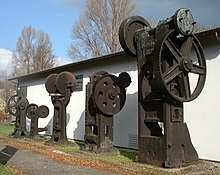Our website is made possible by displaying online advertisements to our visitors.
Please consider supporting us by disabling your ad blocker.
Machine Age
| History of technology |
|---|



The Machine Age[1][2][3] is an era that includes the early-to-mid 20th century, sometimes also including the late 19th century. An approximate dating would be about 1880 to 1945. Considered to be at its peak in the time between the first and second world wars, the Machine Age overlaps with the late part of the Second Industrial Revolution (which ended around 1914 at the start of World War I) and continues beyond it until 1945 at the end of World War II. The 1940s saw the beginning of the Atomic Age, where modern physics saw new applications such as the atomic bomb,[4] the first computers,[5] and the transistor.[6] The Digital Revolution ended the intellectual model of the machine age founded in the mechanical and heralding a new more complex model of high technology. The digital era has been called the Second Machine Age, with its increased focus on machines that do mental tasks.
- ^ Mentality and freedom By William Armstrong Fairburn. Page 219.
- ^ The Playground, Volume 15 By Playground and Recreation Association of America
- ^ Public libraries, Volume 6
- ^ "1944: Princeton builds the A-bomb".
- ^ "Archived copy". Archived from the original on 2011-05-19. Retrieved 2011-06-03.
{{cite web}}: CS1 maint: archived copy as title (link) - ^ "The First Transistor Invented in 1947".
Previous Page Next Page


